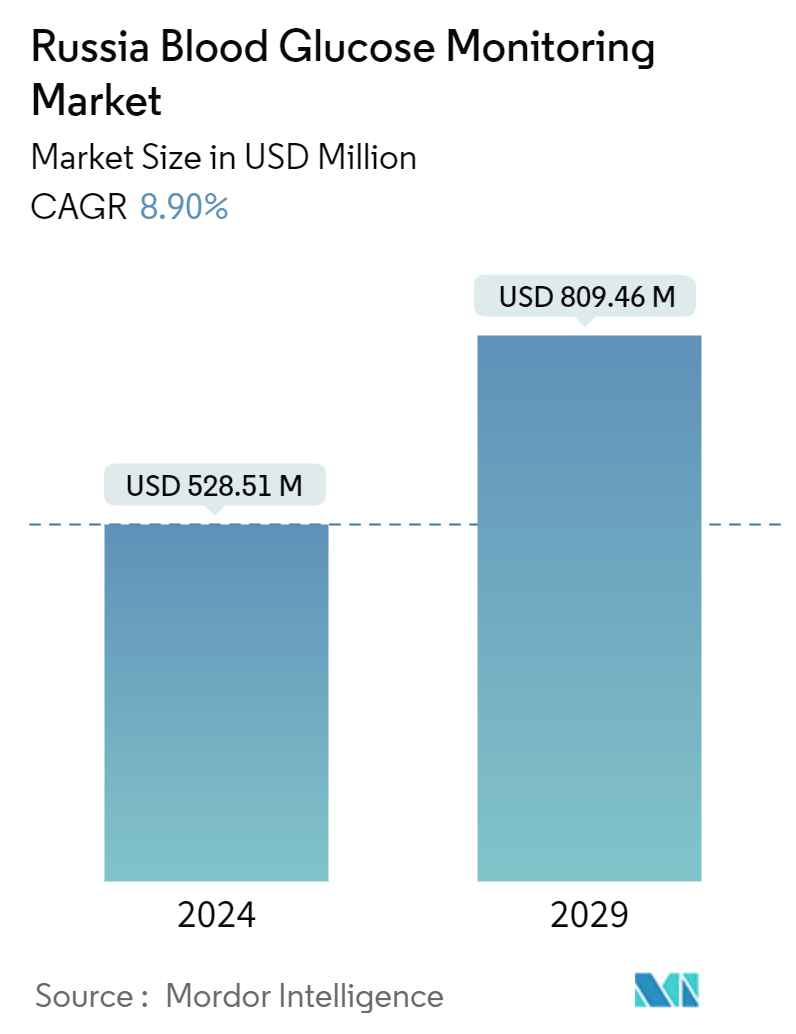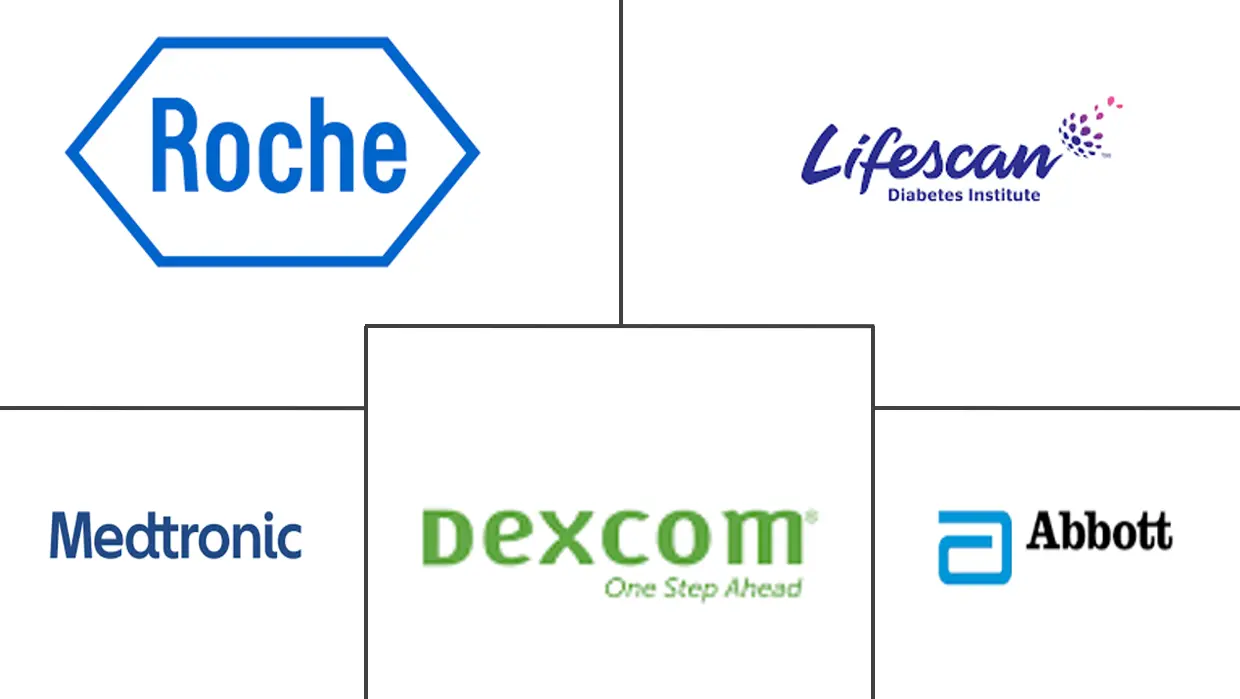Market Size of Russia Blood Glucose Monitoring Industry

| Study Period | 2019 - 2029 |
| Base Year For Estimation | 2023 |
| Forecast Data Period | 2024 - 2029 |
| Market Size (2024) | USD 528.51 Million |
| Market Size (2029) | USD 809.46 Million |
| CAGR (2024 - 2029) | 8.90 % |
Major Players
*Disclaimer: Major Players sorted in no particular order |
Russia Blood Glucose Monitoring Market Analysis
The Russia Blood Glucose Monitoring Market size is estimated at USD 528.51 million in 2024, and is expected to reach USD 809.46 million by 2029, growing at a CAGR of 8.90% during the forecast period (2024-2029).
Russia is currently facing a significant challenge with the increasing number of diabetes cases, which has major implications for the health of its population. Recent data from the International Diabetes Federation (IDF) reveals that Russia is among the top ten countries worldwide in terms of the number of adults aged 20-79 years living with diabetes. The IDF estimates that approximately 11.4 million adults in Russia have diabetes, affecting around 7.8% of the adult population. This alarming prevalence indicates a growing epidemic that requires immediate attention and collaborative efforts from healthcare authorities and policymakers
There are several factors contributing to the high prevalence of diabetes in Russia. Sedentary lifestyles, poor dietary habits, and a rising rate of obesity are significant drivers of the disease. Moreover, limited access to healthcare services, particularly in remote and rural areas, hinders early diagnosis and proper management of diabetes. Socioeconomic factors, including poverty and disparities in healthcare access, further worsen the situation, disproportionately affecting vulnerable populations.
The implications of the diabetes epidemic in Russia are far-reaching, extending beyond individual health outcomes to socioeconomic burdens on the healthcare system and the overall economy. Complications associated with diabetes, such as cardiovascular disease, kidney failure, and lower limb amputations, place a heavy strain on public health resources and productivity.
Addressing this crisis necessitates a comprehensive approach that includes preventive measures, early detection, improved healthcare access, and comprehensive management strategies. Collaborative efforts between government agencies, healthcare providers, community organizations, and educational institutions are vital in curbing the prevalence of diabetes and minimizing its impact on the health and well-being of the Russian population.
Therefore, owing to the aforementioned factors the studied market is anticipated to witness growth over the analysis period.
Russia Blood Glucose Monitoring Industry Segmentation
A blood glucose monitoring device is a medical tool designed to measure the concentration of glucose in a person's blood. These devices are primarily used by individuals with diabetes to monitor their blood sugar levels, helping them manage their condition effectively. Russia's blood glucose monitoring market is segmented into types. The report offers the value (in USD) and volume (in units) for the above segments.
| Self-monitoring blood glucose devices | |
| Glucometer Devices | |
| Test Strips | |
| Lancets |
| Continuous blood glucose monitoring devices | |
| Sensors | |
| Durables (Receivers and Transmitters) |
Russia Blood Glucose Monitoring Market Size Summary
The Russia blood glucose monitoring market is poised for significant growth, driven by the increasing prevalence of diabetes within the country. As one of the top ten nations globally in terms of adult diabetes cases, Russia faces a pressing health challenge that necessitates immediate and coordinated efforts from healthcare authorities and policymakers. The rise in diabetes is attributed to factors such as sedentary lifestyles, poor dietary habits, and limited access to healthcare services, particularly in remote areas. These challenges are compounded by socioeconomic issues like poverty and healthcare disparities, which disproportionately affect vulnerable populations. The implications of this diabetes epidemic extend beyond individual health, imposing substantial socioeconomic burdens on the healthcare system and the economy. To address this crisis, a comprehensive approach involving preventive measures, early detection, and improved healthcare access is essential. Collaborative efforts among government agencies, healthcare providers, and community organizations are crucial in mitigating the impact of diabetes on the Russian population.
The market for blood glucose monitoring in Russia is expected to expand, supported by advancements in technology and the development of continuous glucose monitoring (CGM) devices. These devices offer enhanced accuracy and real-time monitoring capabilities, surpassing traditional self-monitoring methods. The market is characterized by a mix of major players and generic manufacturers, with companies like Dexcom, Medtronics, and Abbott leading the CGM segment. Recent technological innovations have strengthened the market presence of these companies, with partnerships and product developments aimed at overcoming existing challenges in diabetes care. The ongoing efforts to improve reimbursement systems, limit out-of-pocket expenses, and implement national screening programs are expected to further drive market growth. As the prevalence of diabetes continues to rise, the demand for effective blood glucose monitoring solutions in Russia is anticipated to increase, fostering a dynamic and evolving market landscape.
Russia Blood Glucose Monitoring Market Size - Table of Contents
-
1. MARKET DYNAMICS
-
1.1 Market Overview
-
1.2 Drivers
-
1.3 Restraints
-
1.4 Porter's Five Forces Analysis
-
1.4.1 Bargaining Power of Suppliers
-
1.4.2 Bargaining Power of Consumers
-
1.4.3 Threat of New Entrants
-
1.4.4 Threat of Substitute Products and Services
-
1.4.5 Intensity of Competitive Rivalry
-
-
-
2. MARKET SEGMENTATION
-
2.1 Self-monitoring blood glucose devices
-
2.1.1 Glucometer Devices
-
2.1.2 Test Strips
-
2.1.3 Lancets
-
-
2.2 Continuous blood glucose monitoring devices
-
2.2.1 Sensors
-
2.2.2 Durables (Receivers and Transmitters)
-
-
Russia Blood Glucose Monitoring Market Size FAQs
How big is the Russia Blood Glucose Monitoring Market?
The Russia Blood Glucose Monitoring Market size is expected to reach USD 528.51 million in 2024 and grow at a CAGR of 8.90% to reach USD 809.46 million by 2029.
What is the current Russia Blood Glucose Monitoring Market size?
In 2024, the Russia Blood Glucose Monitoring Market size is expected to reach USD 528.51 million.

